Diet for gout and high uric acid: what can and cannot be eaten?
A competent diet for gout is the same element of therapy as medicines, physiotherapy and therapeutic exercises. The use of prohibited foods reduces the effectiveness of therapy, fills the cells with purines, and provokes the active production of uric acid. The result is increased discomfort, severe joint pain, increased swelling, poor tests.
When developing a treatment regimen, the doctor reminds the patient how important a diet is for gout and high uric acid, what can and cannot be done. A table of products that positively and negatively affect the metabolism of uric acid in the body will help you create a menu for gout every day.

Why you need to follow a diet?
The main point of the gout diet is to control the production and excretion of uric acid. Such a nutrition system helps to improve well-being and reduce pain, as a result of which the disease recedes.
The consequences of non-compliance with the diet for gout include:
- kidney disease (gouty nephritis);
- development of renal failure;
- arterial hypertension and damage to the cardiovascular system;
- damage to other internal organs with the formation of gouty nodes in them (heart, lungs, brain);
- atherosclerosis;
- damage to all joints and the development of erosive arthritis.
It should be noted that this diet does not cure, but only contributes to the accelerated release of acid and salts during exacerbation of arthrosis. It also significantly reduces body weight, which plays an important role in the recovery of the body after heavy drug therapy.
Varieties
Diet 6E refers to the varieties of Table No. 6. It is prescribed for similar indications to patients with obesity. The energy value is reduced to 1950-2000 Kcal (protein content at the level of 70 g, fat - 80 g, carbohydrates - at the level of 250 g).
Basically, the consumption of simple carbohydrates (fresh wheat bread, sugar, honey, sweets, confectionery and flour products) is reduced, and less complex carbohydrates (cereals). Meat intake is limited to 1-2 times a week. Meals in small portions (fractional) up to 5-6 times a day, abundant fluid intake, especially weakly alkaline mineral waters.
Vegetables and fruits are best consumed raw, but can be baked and boiled. Since the diet is not physiologically complete, it can be prescribed for a period of no more than 2 weeks.
Basic principles of nutrition for gout
It is important to follow a few recommendations for the formation of a daily diet. Diet for gout and high uric acid what can and cannot include the following rules:
- Eat the right fats. When reducing the level of animal fats in the diet, include vegetable oils, in particular, olive, sunflower, corn oils.
- Reduce weight. Excess body weight aggravates the course of the disease, provokes a violation of the kidneys, and excludes the possibility of normal excretion of uric acid. If you are overweight, reduce the energy value of the diet.
- Drink a lot. In the absence of edema and normal functioning of the kidneys, abundant fluid intake is recommended. It is important for you to drink at least two and a half liters of liquids per day, including plain water with the addition of lemon juice, as well as fruit and berry juices, herbal teas, rosehip broth, and milk.
- Take multivitamins. It is especially important for the correction of the condition to consume a sufficient amount of vitamins C, PP and B2.
- Eat foods that alkalize your urine. These include almost all fresh fruits and berries. Their value in the diet also lies in the high content of potassium, which has a diuretic effect.
- Drink alkaline mineral water. It alkalizes urine, which makes its composition active against uric acid. The alkaline reaction of urine promotes the dissolution of dangerous compounds and reduces the risk of disease progression.
- Eliminate alcohol. Alcoholic drinks disrupt the functioning of the kidneys, which eliminates the possibility of removing uric acid from the body. Even their periodic intake can provoke an attack and exacerbation.
- Reduce the salt content. By itself, salt contributes to the deposition of uric acid crystals in the joints. Its increased content in food reduces the intensity of urine excretion and causes swelling, which eliminates the necessary diuretic effect during exacerbations. Reduce the amount of salt in your meals to a minimum.
It is also worth arranging fasting days. Once a week, arrange for the body to unload from plentiful food. What is good for you is one-day mono-diets on foods poor in purines. In the summer, arrange fasting days on watermelons, which perfectly remove uric acid and salts from the body. In spring and autumn, use cucumber and apple mono-diets. In winter, potatoes are suitable. All of these foods are rich in potassium and fiber that are valuable to you.
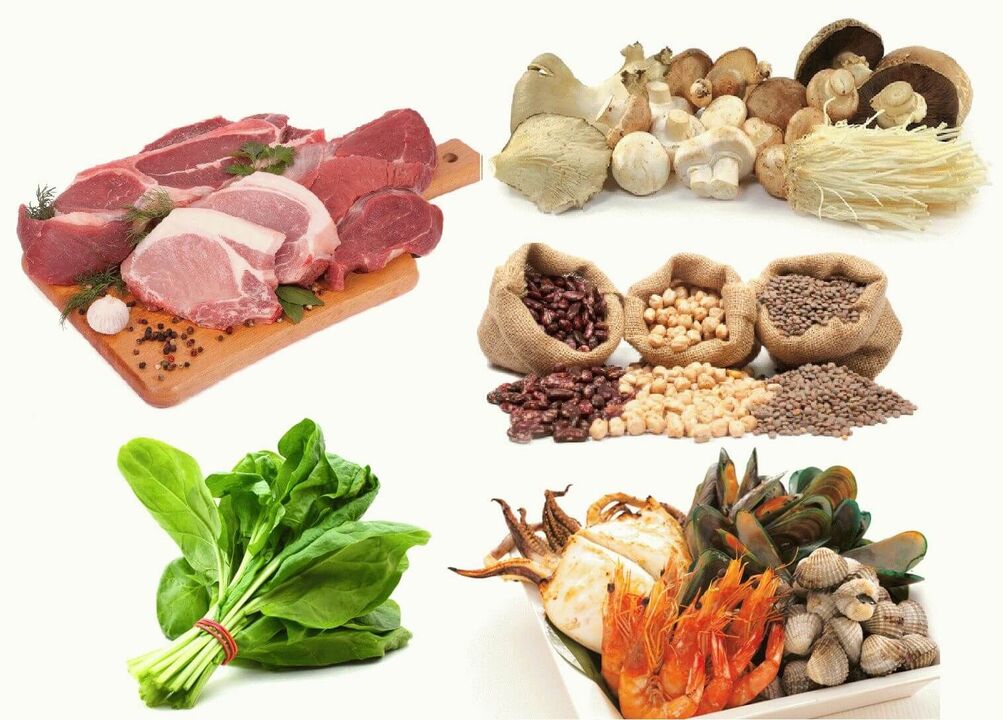
Diet for gout during an exacerbation
During an exacerbation of gout, a properly selected diet will help get rid of unpleasant painful symptoms and restore mobility, which a person loses during the development of inflammation. From the menu, you can completely exclude meat and fish products.
Nutrition for gout provides for more frequent fasting days (every other day). With an exacerbation, you can use the following menu for 1 day:
- On an empty stomach: half a glass of preheated mineral alkaline water or rosehip broth (you can use chicory).
- Breakfast: half a serving of oatmeal milk porridge (it should be liquid), a glass of milk.
11 o'clock: 1 glass of apple juice. Instead, you can eat raw apples (1 pc. ). - Lunch: pureed vegetable soup (half serving), milk-based jelly.
5 p. m. : Carrot or tomato juice (glass). - Dinner: half a serving of liquid milk rice porridge, 1 glass of fruit compote (strawberries, pears, apples).
21: 00: a glass of kefir. - At night: tea with milk and honey (not desirable for diabetes) or green tea without sugar - 1 cup.
This menu can be used until the symptoms of inflammation in the legs disappear.
What can you eat with gout?
Gout is not a simple disease that requires a responsible attitude and adherence to the principles of proper nutrition. Therefore, it is necessary to understand what you can eat with gout. The table of products will help us with this.
Diet for gout and high uric acid what you can eat, food table:
| List of foods to eat: | Features of use: |
| Black or white bread, inedible pastries. | |
| Marshmallow, marmalade, jam, marshmallow, non-chocolate candies, ice cream. | |
| Milk-based cereals, vegetarian borscht, potato soups with cereals, fresh and pickled vegetable salads, vinaigrette, vegetable caviar, vegetable, milk or sour cream sauce. | Milk in this case should be diluted. |
| Oranges, tangerines, green apples, dates, persimmons, dried fruits (except raisins), strawberries, lemons, apricots, pears. | Naturally, one should not eat fruits alone and in large quantities. Food should be complete and varied. |
| Dill, corn, beets, onions, garlic, potatoes, carrots, white cabbage, cucumbers, zucchini, eggplant, tomatoes, pumpkin (helps improve metabolism). | Garlic is the most useful, as it helps to eliminate the inflammatory process. In addition, vegetables are actively used during fasting days. Potatoes and cucumbers have a large amount of potassium, therefore, they increase the excretion of uric acid from the body. |
| All cereals except legumes. | Beans are on the list of foods that you can not eat, as they contain uric acid, and in large quantities. |
| Marine cephalopods, crustaceans, shrimp, lean fish (salmon, trout), squid. | These foods for gout are very useful. The diet provides for boiled fish, and it is advisable to drain the broth. |
| Rabbit, turkey, chicken. | Any meat is consumed 2-3 times a week and no more than 170 g. |
From drinks you can: green tea, tea from fruits and berries, tea with milk and lemon, juice (any, even tomato), herbal decoctions, fruit drinks, compotes from fruits and berries, fresh cucumber juice, alkaline mineral water for gout is also very useful, rosehip broth, chicory.
What can not be eaten with gout?
If the patient has damage to the joints on the legs, you need to find out what you can not eat with gout. The fact is that while following a diet, some foods (even fruits) are not recommended to be consumed, as they contain a certain amount of purines. It is impossible to cure or at least eliminate the symptoms without proper nutrition.
Diet for gout and high uric acid what not to eat, food table:
| Meat and poultry | smoked, raw-smoked and boiled sausages, sausages, sausages, meat of young animals, fatty pork meat, offal (lungs, liver, kidneys), canned food |
| Dairy products, eggs | salty and spicy cheeses |
| Seafood, fish | fatty, salted, smoked or fried fish (sardines, sprats, cod), caviar |
| Vegetables | mushrooms, sorrel |
| cereals | lentils, beans, soybeans, beans |
| Sweets | cream cakes, pastries |
| Dishes | meat, fish or mushroom broth, sorrel soup, as well as dishes with legumes and spinach; sauces based on the above broths, mayonnaise |
| Spices | pepper, mustard, horseradish, hot spices |
| Fats | margarine, fat |
| Fruits, berries | grapes, figs, raspberries |
From drinks it is impossible to use: any alcohol, especially beer and wine; coffee, cocoa, strong tea (despite the fact that the presented drinks contain purines, they do not break down into uric acid, however, they have a strong diuretic effect that contributes to dehydration).
Sample menu for gout
A therapeutic diet for gout reduces the risk of recurrence of the disease, relieves pain, and normalizes the functioning of the urinary system. In addition, such a nutrition system contributes to the normalization of body weight and is one of the principles of a healthy lifestyle.
Diet for gout and high uric acid what is possible and what is not, an approximate menu:
First day:
- Before meals: a glass of rosehip broth.
- 1 breakfast: tea with milk, cabbage salad.
- 2 breakfast: vegetable juice.
- Lunch: borsch on vegetable broth, a piece of boiled meat with white sauce (no more than 100 gr. )
- Afternoon snack: a glass of rosehip broth.
- Dinner: buckwheat with milk, vegetable cabbage rolls.
- Before going to bed: fruit juice.
Second day:
- Before meals: a glass of rosehip broth.
- 1 breakfast: tea with milk, beetroot salad dressed with butter or sour cream.
- 2 breakfast: vegetable juice.
- Lunch: vegetable soup with pearl barley, cabbage schnitzel.
- Afternoon snack: fruit juice.
- Dinner: carrot cutlets, jelly.
- Before going to bed: watermelon or a glass of curdled milk.
The list of dishes can be combined, do not forget that the effect of diet therapy can be achieved and fixed for a long time only if it is fully observed.
Recipes for gout
Recipes for gout are very easy to prepare and do not require special preparation or a specific set of products. At home, anyone can repeat them.
Light creamy soup
Required products: 1 carrot, 1 onion, champignons, 2 tablespoons of lemon juice, ½ teaspoon of sugar, 2 tablespoons of sunflower oil, cream 30 g.
Preparation: We clean and chop vegetables. We spread the cooked carrots and onions in a saucepan with heated oil, put on fire, simmer for 7-8 minutes. Add spinach leaves and blend until puree. Add lemon juice, sugar and let it boil, when serving, put cream on a plate.
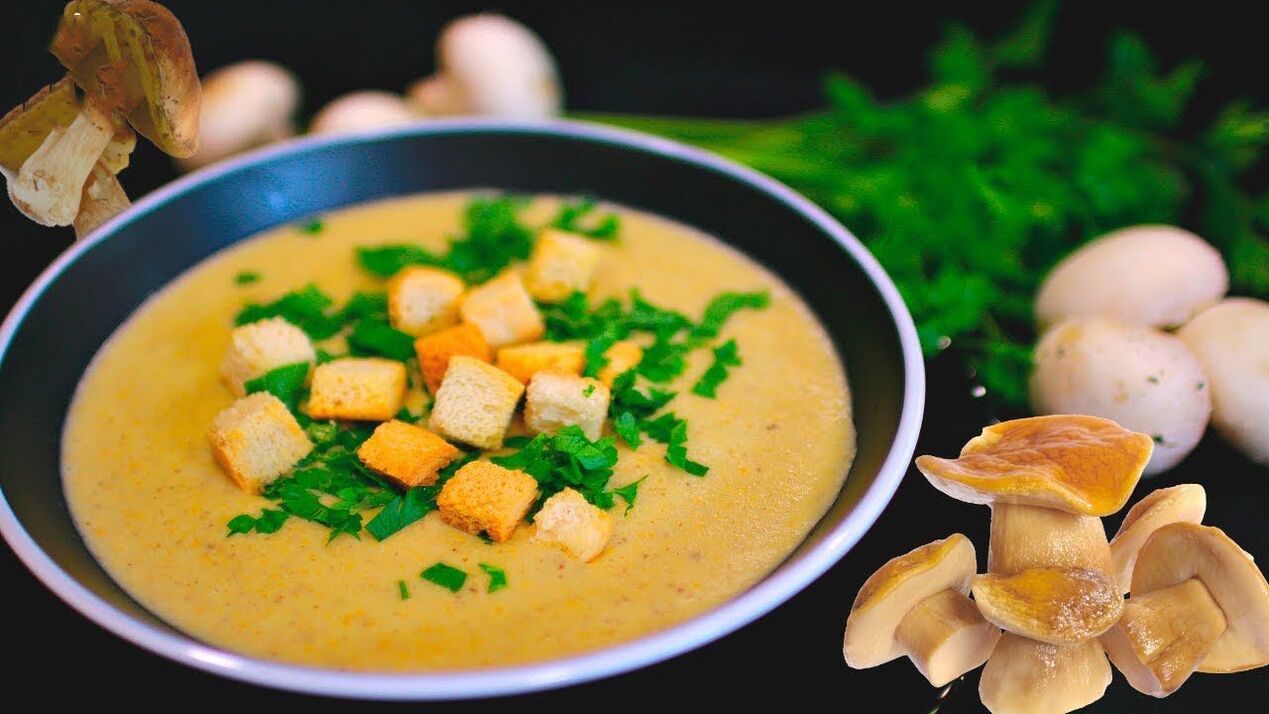
Cottage cheese casserole
Products: 3 chicken eggs, 100 g semolina, 100 g sugar, 2 packs of cottage cheese, 200 g low-fat sour cream, dried fruits, salt, soda slaked with lemon juice.
Preparation: Thoroughly mix all the ingredients, add 0. 5 teaspoon of soda, hydrated with lemon juice, raisins. Pour the resulting mass into the prepared baking dish and bake in the oven at 180 degrees until lightly browned.
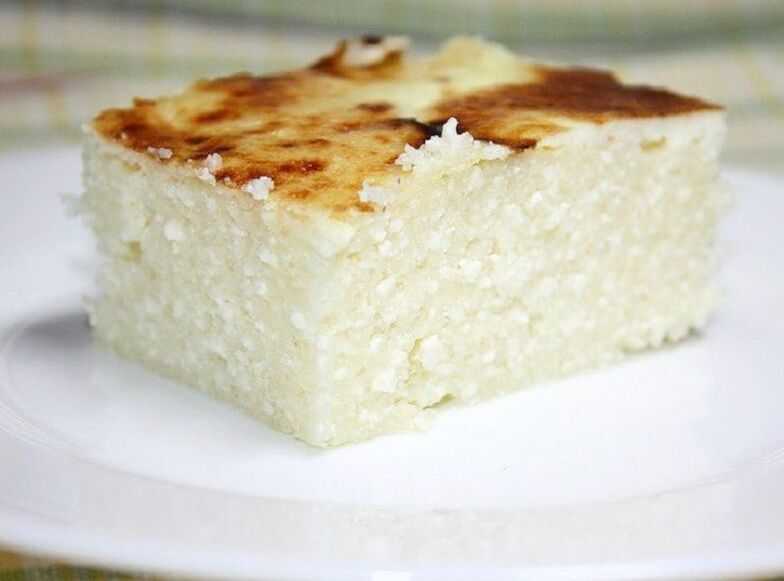
Steamed chicken meatballs with gravy
Products: Chicken fillet 350 g, 70 g onion, 30 ml milk, 1 chicken egg, 150 g boiled rice, 70 g white bread, pepper. Salt, herbs. For gravy: 150 g carrots, 200 ml chicken broth, 50 g herbs, 70 g onions, vegetable oil, 50 g sour cream, 15 g wheat flour, salt, pepper, green onions for serving.
Preparation: Cut the chicken fillet, put it in a blender, add onion, raw chicken egg and bread soaked in milk, pepper, dry dill. Grind thoroughly. Add boiled cold rice, fine table salt and knead minced meat for meatballs, let stand for 20 minutes in the refrigerator. We form meatballs and cook for a couple of 6-8 minutes. We pass onions and carrots, add chicken broth, herbs, wheat flour, salt to taste sour cream. Warm up on low heat. We put steam meatballs in the finished gravy and cook for another 5-6 minutes, sprinkle with green onions.
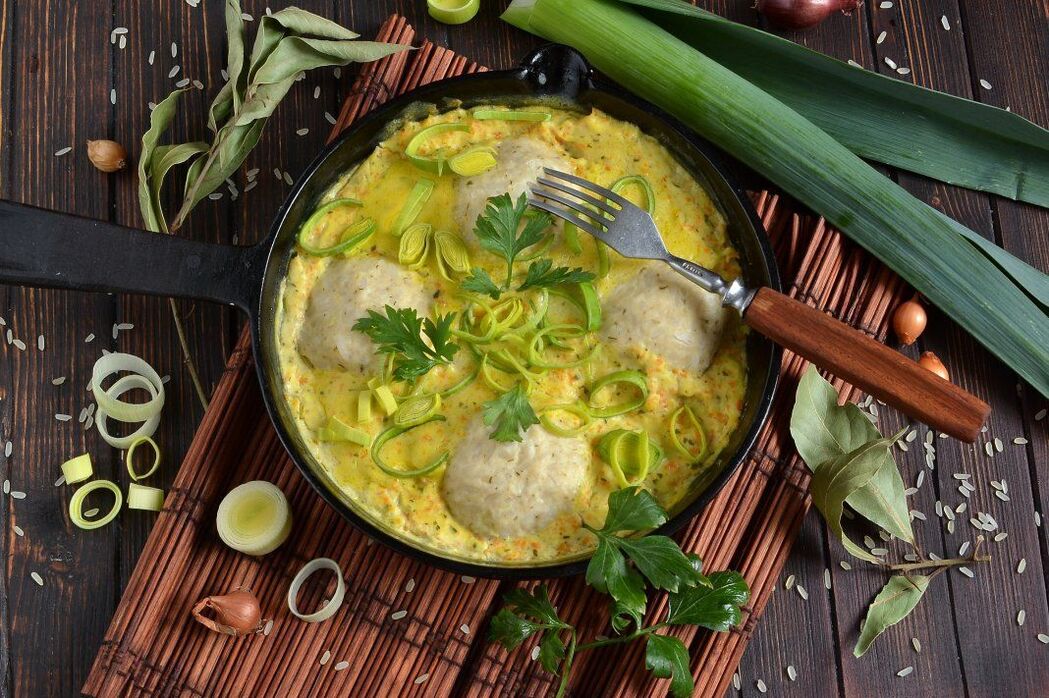
Eggplant and minced meat casserole
Products: eggplant, flour, vegetable oil, onion, garlic, minced meat, tomato paste, cheese, cream, black pepper, salt.
Preparation: Sprinkle slices of eggplant cut lengthwise with salt, pepper to taste, roll in flour and fry a little in vegetable oil on both sides. Let the garlic and onion go until golden brown, add the minced meat and simmer for 3 minutes. Add tomato paste, pepper and salt and water (1/2 tbsp. ) Simmer for another 2 minutes. Put eggplants, minced meat and grated cheese in layers in a form, pour over cream and bake for half an hour in a preheated oven, temperature - 180˚С.
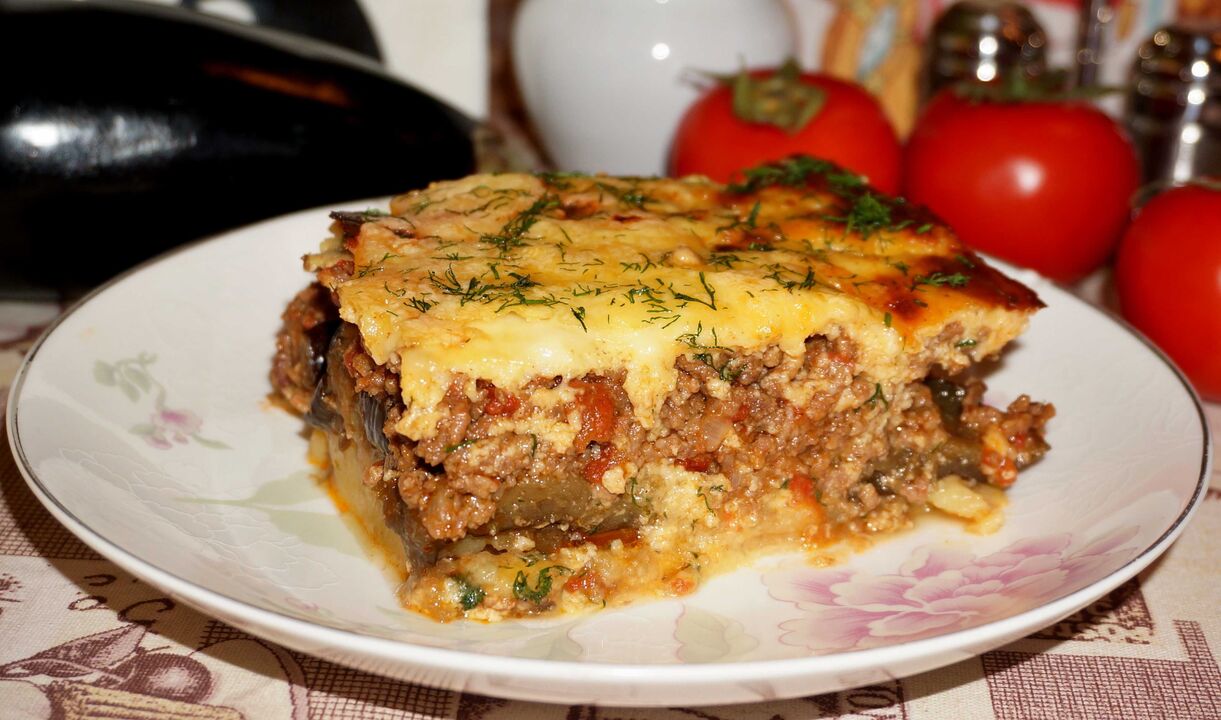
Pumpkin puree soup
Products: water - 1 liter; pumpkin (pre-peel) - 500 g; butter - 2 tbsp. l. ; rice - 2 tbsp. l. ; milk - 2 tbsp. ; sugar - 1 tbsp. l. ; salt - on the tip of a knife.
Preparation: We put diced pumpkin, washed rice, salt and sugar in a saucepan, pour water and cook until tender. Pour with melted butter, rub everything through a sieve or chop with a blender and pour in boiled milk. Let the soup boil, and season with boiled cream.
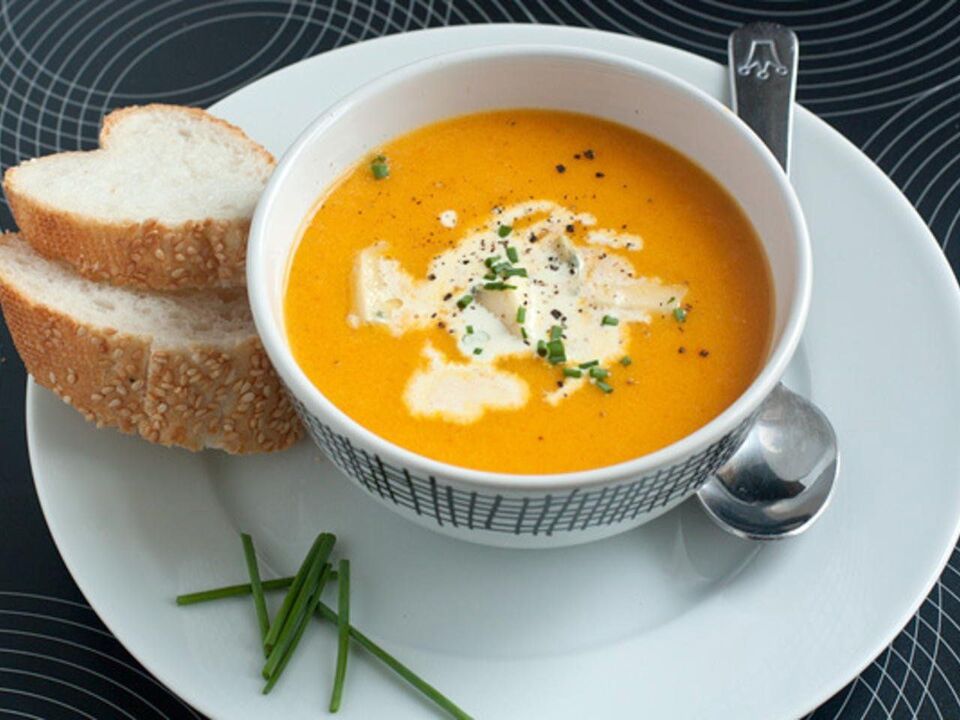
To avoid painful symptoms, at the first alarming signs, seek medical help and strictly follow all the recommendations of your doctor. Including those that relate to nutritional adjustments. An experienced nutritionist will help you create the right menu, who will tell you what you can eat with an increased concentration of uric acid, and which foods should be abandoned forever.












































